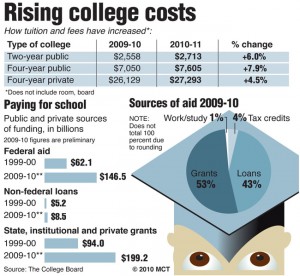
For many students at CSU East Bay, the Cal Grant has been a major financial boom that serves to make college more accessible, but the grant has also failed to adequately address students’ needs to the fullest extent.
While this may be in large part simply due to the lack of funds available for public education in California, another contributing factor is how the California Student Aid Commission (CSAC), in conjunction with the CSU system, determines eligibility for its programs.
Cal Grant eligibility is currently determined based on a number of factors that include educational level, financial need and GPA standing. The bone of contention among the three listed here is educational level.
The CSU system educational level is determined based on the number of units completed by a student. This being the case, a full-time student will generally run out of Cal Grant eligibility after a period of four years unless they are part of a verified five-year program or go on to complete a teaching credential program.
However, determining educational level based solely on units earned disregards how close the student is to actually completing a degree or graduating from the university. This leaves a population of students who meet other Cal Grant requirements to lose their financial aid before they can graduate despite demonstrated need.
According to U.S. News, the average number of students who graduate within four years among a number of the CSU campuses is 13.7 percent. For CSUEB, that number is 15 percent.
This simply means that the vast majority of students not only at CSUEB but also among other CSU campuses are not meeting the criteria set out with the current educational level requirement for the Cal Grant.
Granted, many students cannot manage a full-time schedule with other concerns like work and family thus distorting the number, but there are also a large number of students who are unable to decide upon their educational path during that period.
That leaves students who come to college unsure of their futures in a tightening bind to make rash decisions about their education without necessarily having the time to take the courses that will help them make those decisions before their unit total restricts eligibility for the Cal Grant.
While it is true that the CSAC should not promote wasting of funds through lax requirements on degree progress, when looking at the small rate of students graduating within four years it seems obvious that the current system needs to be adjusted.
At CSUEB, a large number of students are already financially underserved. According to U.S. News, only 1.3 percent of students had their financial needs fully met and, on average, students who do receive some type of financial aid only had 55 percent of their need met.
Something clearly needs to change in our financial aid system. If the overarching issue is California’s budget problems than our legislature must better address the allocation of funds to the public education system.
However, one way in which we can quickly see positive change in financial aid on campus is to change how educational level is determined to better reflect progress on degree completion instead of focusing on the number of units completed.
With the average under six-year graduation rate at CSU East Bay standing at 44 percent, it seems clear that students on this campus need to be here longer and need the money to stay. For comparison, the average under six-year graduation rate for the top 25 western universities is 67.84 percent, according to U.S. News.
The Cal Grant has been a very beneficial program for students in the California public education system, but it needs to improve to better reflect the needs of its student population.








